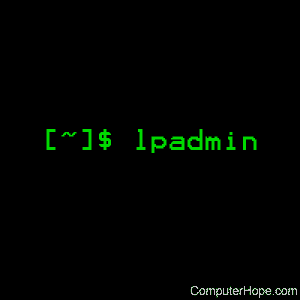Linux lpadmin command

On Unix-like operating systems, the lpadmin command configures the lp print service.
Description
lpadmin configures printer and class queues provided by the common printing system CUPS. It can also be used to set the server default printer or class.
When specified before the -d, -p, or -x options, the -E option forces encryption when connecting to the server.
The first form of the command (-d) sets the default printer or class to destination. Subsequent print jobs submitted via the lp or lpr commands use this destination unless the user specifies otherwise with the lpoptions command.
The second form of the command (-p) configures the named printer or class. The additional options are described below.
The third form of the command (-x) deletes the printer or class destination. Any jobs that are pending for the destination will be removed and any job that is currently printed will be aborted.
Syntax
lpadmin [ -E ] [-U username ] [ -h server[:port] ] -d destination
lpadmin [ -E ] [-U username ] [ -h server[:port] ] -p destination
[ -R name-default ] option(s)
lpadmin [ -E ] [-U username ] [ -h server[:port] ] -x destination
Options
The following options configure the printer queue.
| -c class | Adds the named printer to class. If class does not exist it is created automatically. |
| -i interface | Sets a System V style interface script for the printer. This option cannot be specified with the -P option (PPD file) and is intended for providing support for legacy printer drivers. |
| -m model | Sets a standard System V interface script or PPD file for the printer from the model directory or using one of the driver interfaces. Use the -m option with the lpinfo command to get a list of supported models. |
| -o cupsIPPSupplies=true, -o cupsIPPSupplies=false |
Specifies whether IPP supply level values should be reported. |
| -o job-k-limit=value | Sets the kilobyte limit for per-user quotas. The value is an integer number of kilobytes; one kilobyte is 1024 bytes. |
| -o job-page-limit=value | Sets the page limit for per-user quotas. The value is the integer number of pages that can be printed; double-sided pages are counted as two pages. |
| -o job-quota-period=value | Sets the accounting period for per-user quotas. The value is an integer number of seconds; 86,400 seconds are in one day. |
| -o job-sheets-default=banner, -o job-sheets-default=banner,banner |
Sets the default banner page(s) to use for print jobs. |
| -o name=value | Sets a PPD option for the printer. PPD options can be listed using the -l option with the lpoptions command. |
| -o name-default=value | Sets a default server-side option for the destination. Any print time option can be defaulted, e.g., "-o cpi-default=17" to set the default "cpi" option value to 17. |
| -o port-monitor=name | Sets the binary communications program to use when printing, "none", "bcp", or "tbcp". The default program is "none". The specified port monitor must be listed in the printer's PPD file. |
| -o printer-error-policy=name | Sets the error policy to be used when the printer backend cannot send the job to the printer. The name must be one of "abort-job", "retry-job", "retry-current-job", or "stop-printer". The default error policy is "stop-printer" for printers and "retry-current-job" for classes. |
| -o printer-is-shared=[true|false] | Sets the destination to shared/published or unshared/unpublished. Shared/published destinations are publicly announced by the server on the LAN based on the browsing configuration in cupsd.conf, while unshared/unpublished destinations are not announced. The default value is "true". |
| -o printer-op-policy=name | Sets the IPP operation policy associated with the destination. The name must be defined in the cupsd.conf in a Policy section. The default operation policy is "default". |
| -R name-default | Deletes the named option from printer. |
| -r class | Removes the named printer from class. If the resulting class becomes empty it is removed. |
| -u allow:user,user,@group -u deny:user,user,@group -u allow:all -u deny:none |
Sets user-level access control on a destination. Names starting with "@" are interpreted as UNIX groups. The latter two forms turn user-level access control off. |
| -v "device-uri" | Sets the device-uri attribute of the printer queue. Use the -v option with the lpinfo command to get a list of supported device URIs and schemes. |
| -D "info" | Provides a textual description of the destination. |
| -E | Enables the destination and accepts jobs; this is the same as running the cupsaccept and cupsenable programs on the destination. |
| -L "location" | Provides a textual location of the destination. |
| -P ppd-file | Specifies a PostScript Printer Description file to use with the printer. If specified, this option overrides the -i option (interface script). |
Examples
lpadmin -p LaserJet -E -v socket://10.1.1.1 -m laserjet.ppd
Add a printer named Laserjet which is at the network location 10.1.1.1, using the CUPS driver file laserjet.ppd.
Related commands
enable — Enable and disable LP printers.
lp — Print a file on the System V operating system.
lpstat — List the status of the LP print services.
mail — Read, compose, and manage mail.
stty — Set options for your terminal display.
